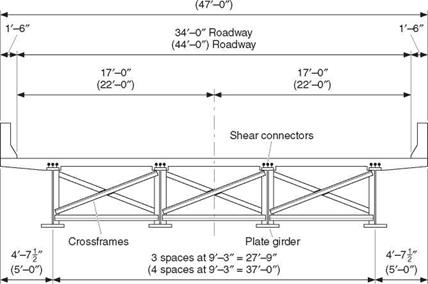Welded Steel Plate Girder Bridge
The welded steel plate girder bridge (Fig. 4.9) extends the span range of deck-type bridges (bridges having all the structural support below the deck slab) well beyond the range of rolled steel beams or precast prestressed-concrete beams.
|
37-0"
|
Whereas haunched girders were economical in the past for long spans, the current practice, strongly advocated by the steel-fabricating industry, is to use parallel-flange girders wherever possible. This is an economic consideration rather than an aesthetic one. Properly configured haunched girders are thought by many to be more pleasing. They permit a shallower structure depth at mid span, which can result in a lower grade line and consequent savings in roadway construction cost. However, parallel-flange girders can be fabricated more rapidly and economically than haunched girders. As an example of long-span parallel-flange steel girder construction, the Tennessee DOT has designed a continuous 1717-ft-long (523-m) parallel-flange five-span steel plate girder bridge of girder-floor beam-stringer type construction, including two spans of 460 ft (140 m) each. This design uses ASTM A36 and A572 steel in the webs, and A572 and A517 steel in the flanges. The A517 steel, which has a minimum yield strength of 100 kip/in2 (690 MPa), is used for the flange plates at points of maximum stress over the piers and at mid span of one of the 460-ft (523-m) spans.
In designing a steel plate girder bridge for economy, designing for minimum weight does not always result in the most economical girder. The cost saved by reducing web or flange plate width or thickness may be more than offset by the cost of making the welded splices. Cost data should be obtained from local fabricators to make this comparison. One rule of thumb is that the weight saved by a change of flange plate thickness should be at least 1500 lb (680 kg). Also, it is generally desirable to use a constant-width flange plate to reduce fabrication and construction costs.
The use of excessively thin webs and narrow flanges, while saving weight, can result in flimsy sections that require special handling and erection equipment such as strongbacks. If such measures are not employed, the girder may be damaged in handling. Either consequence may more than offset the cost saved through weight reduction. For this reason many states have adopted minimum plate dimensions that are greater than minimum requirements of AASHTO or industry recommendations.







Leave a reply